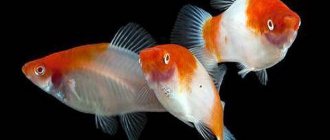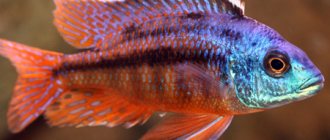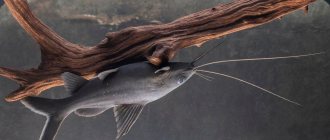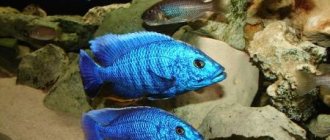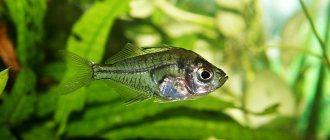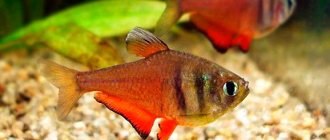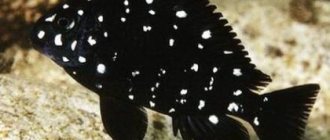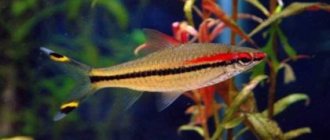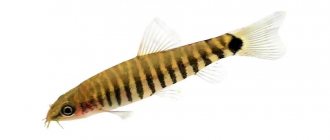Graceful Sturisoma panama – one of the most popular representatives of the genus Sturisoma in aquarium farming. It quickly adapts to captivity, withstands a wide variety of water parameters, and copes well with colonies of unwanted algae on glass and decorations. This aquarium fish has a strongly elongated body, flattened at the bottom. The tail stalk is very thin. When viewed from above, the head of males is shorter and wider than that of females. Both have large fins with long, crescent-shaped first rays. “Camouflage” color: brown, with a yellow pattern.
Feeding
Sturisomes are quite large and agile fish. They need a lot of food. Food competitors (pterygoplichths, ancistrus) become a significant problem for them. A well-fed sturisoma should have a round, clearly defined abdomen. Hunger can cause depression and death. The diet is made up of various foods: animal (live and frozen food for aquarium fish, finely chopped beef, large brine shrimp, shellfish and shrimp, earthworms) and plant (lettuce, pieces of zucchini and cucumber).
Sturisoma Panama in a 150 l aquarium
Keeping Panamanian Sturisoma in an aquarium
In addition to external and behavioral factors, they bring invaluable benefits, brilliantly cleaning snags, boulders and aquarium glass from unpleasant algae fouling, including the hated “flip-flop” (Compsopogon caeruleus). In addition, work to keep the underwater landscape clean has a beneficial effect on other fish, in fact being an important anti-stress factor.
Having been caught in the wild, the Panamanian sturisoma quickly adapts to life in an aquarium, actively scraping algal fouling from the walls, decorations and plants.
Despite the apparent slowness of the sturisoma , most of the time of the day is spent scraping fouling from various interior items of the aquarium and, if necessary, smoothly moving from one place to another. It is difficult to imagine that when trying to catch it, such a phlegmatic fish can turn into lightning, capable of covering a long distance with one jerk, rapidly flying through dense thickets of plants.
The temperature of the content is 24-26°C, the active reaction of the water is pH 6.5-7.2, the hardness of the water does not matter, Panamanian sturisomes live and reproduce equally well in both very hard and soft water. The main condition is that the water is free of harmful nitrogen compounds (nitrite and ammonium) and is saturated with oxygen.
Sturisoma panama
It should be remembered that sturisomes are quite large and active fish that require a relatively large amount of food, especially if the aquarium contains other chain-mailed catfish, such as ancistrus and loricaria, which are direct food competitors. The diet of the Panamanian sturisoma should consist of both plant food (zucchini, cucumbers, lettuce) and animal origin (various frozen foods, brine shrimp, live bloodworms, lean beef, krill meat, etc.).
Panamanian Sturisomes are peaceful and live up to 8 years in an aquarium.
Behavior
Sturisoma lives in very fast rivers of Panama and Colombia, so it adapts perfectly to artificial flow. It is not afraid of bright light, continuing to actively remove algae and bacterial films from all surfaces. She is very active and is the first to arrive at the feeding site. Males show territoriality only during the spawning period - they attack females, chasing them throughout the aquarium. However, they do not cause any harm.
Sturisoma panamense
Description
Ichthyologists divide chain catfish into two species: Loricariini and Harttiini. By the way, the division is quite transparent and informative, and will help you quickly understand the differences between fish.
Thus, Harttiini live on hard substrates, such as rocks and driftwood, and are often found in streams and rivers with fast and strong currents.
Loricariini live in rivers, where they prefer sandy substrates and fallen tree leaves.
The main difference between these species lies in the way they feed. Thus, Loricariini are omnivores and mainly feed on worms and insect larvae, while Harttiini eat algae and benthos.
In general, Harttiini are more demanding in their maintenance and require special conditions.
There are more than 30 different species of loricaria, most of which have never been commercially available. Among the Loricariini, the aquarium hobby is mostly represented by rhineloricaria Rineloricaria (or Hemiloricaria, according to other sources).
For example, Rineloricaria parva and Rineloricaria sp. L010A. Very rare, but Planiloricaria and Pseudohemiodon are also found.
And Harttiini are mainly represented by various species of rare Farlowella and Sturisoma. Very rarely other species, Lamontichthys and Sturisomatichthys, are found on sale.
Reproduction
Puberty occurs at approximately 18 months. Adult, sexually mature males are distinguished from females by the presence of dense bristles on the cheeks (odontodes) ranging from 1 to 6 mm in length (see last photo below). If conditions for spawning are unsuitable, odontodes may gradually disappear or not appear at all, and then you should not count on breeding aquarium fish.
Females, unlike the male, are paler in color, the fins on the sides are whitish-gray. The female has a narrower, wedge-shaped head and close-set eyes.
The male has a more powerful and wider head, bristles on the side of it, and the eyes are located lower. For laying, the male chooses an area where the current is clearly felt. Usually this is any vertical surface (for example, the glass of an aquarium). Having thoroughly cleaned the place for eggs, he allows the female to approach it. The process itself takes no more than half an hour. Total number of eggs: from 30 to 120. They are large and light in color. Incubation lasts 7-9 days.
Pair of Sturisoma Panama
After hatching, the larvae attach themselves to plants or glass with their suction cup mouth and feed from the yolk sac for up to three days. The females will definitely eat them, so to preserve the offspring, the clutches are cut off even before the fry appear (when the eggs darken to black) and placed in an incubator with the same conditions as in a general aquarium. There is no need to find out how long the fish live without food - as soon as the yolk sac resolves, the fry are fed with Artemia nauplii, cucumber or zucchini pulp (first the vegetables are frozen in the freezer, then defrosted and kneaded).
Reproduction of Panamanian Sturisoma
Panamanian Sturisomes are rheophilic fish that prefer to live in flowing water. To imitate natural habitat conditions during the spawning period, sturisomes require an aquarium with a volume of at least two hundred liters, with a flow. The flow is created through powerful, round-the-clock mechanical and biological filtration.
If suitable conditions are created, Panamanian sturisomes can spawn in a community aquarium. Moreover, the choice of place depends on the current hydrodynamic situation in the aquarium; as a rule, the male chooses a place located in the path of noticeable movement of water, usually a smooth vertical surface, such as a ceramic pipe, a piece of vertically fixed plastic, driftwood or just the wall of the aquarium. By this time, the female usually becomes noticeably rounder and tries to stay close to the male; at first, he actively drives her away, while diligently cleaning the selected substrate. After preparing the spawning area, he allows the female to approach.
Spawning usually occurs at dusk. Spawning itself lasts from 30 minutes to several hours. Sometimes Sturisomes lay eggs on a horizontal (or almost horizontal) platform. In aquariums without soil, this surface can also be a glass bottom.
The incubation period, depending on the temperature, lasts 7-9 days. The hatched larvae leave the laying site and, having attached themselves to glass or plants, live off a small yolk sac for the next two to three days, occasionally moving from one place to another. Females are not averse to snacking on hatched larvae, so only a few manage to survive, and more often than not, all the larvae are eaten.
For targeted breeding of Panama Sturisomes , the producers should be placed in a separate aquarium without soil, equipped with a powerful canister filter and a heater with a thermostat.
Sturisoma Panama with clutch
To successfully breed Panamanian sturisoma , two conditions must be met: abundant and varied nutrition and the presence of a large volume of high-quality running water.
The main difficulty lies in simultaneously meeting the above conditions, since fulfilling the first creates difficulties for fulfilling the second.
Usually spawning is paired, but group spawning is also possible, when two or three females alternately spawn with one male, placing their clutches at a close distance from each other, in a place chosen by the male.
Females can lay eggs up to several days apart, which allows simultaneous observation of eggs at different stages of their development. If the above conditions are met, each female lays from 70 to 120 eggs. The maximum fertility of a female is 160 eggs of light green color, with a diameter of 2.8 millimeters.
The male takes care of all the clutches at the same time, carefully monitoring the movements of the females. And if he has the slightest fear for the life of his future offspring, he quickly takes a place next to the protected clutch. During this period the Panamanian Sturis , because when they see the shadow of a person near the aquarium, they leave the clutch and return to it only when the danger has passed. During the absence of the male, the clutch can be destroyed by females or other fish if spawning took place in a common aquarium.
The sticky, light green eggs darken as they develop and become almost black when the larvae emerge. If the clutch is in the light, the emergence of larvae is delayed; if in the dark, it accelerates.
During artificial incubation, an additional sprayer is placed above the clutch, and methylene blue (0.5 mg/l) is added to the water.
Panamanian sturisomes are capable of spawning in hard water, but in this case the eggs lose their stickiness and the yield of fry is noticeably less than in soft water.
After hatching the larvae, the male relinquishes his responsibilities for further care of the offspring. Neither he, nor the female who laid the eggs, nor the other females from this nest show any interest in the larvae.
For safety reasons, using a glass tube, the larvae should be transplanted into another container with similar conditions.
After about 40 hours, the larvae turn into fry and begin to actively feed.
Their starting food is rotifers, screening out Artemia nauplii, and high-quality dry food for fry.
At one week of age, the fry begin to add crushed and scalded leaves of dandelion, spinach, nettle, cabbage, semolina (cook for less than a minute, then strain), frozen zucchini or cucumber pulp to their diet (peeled vegetables are frozen in the freezer, and the required portion is thawed immediately before use - such vegetables have a soft consistency and are well eaten by fry).
Animal feed is ground using a blender before use. The ratio of plant and animal feed is approximately 7:3.
A small piece of driftwood should be placed in the nursery aquarium; its presence is absolutely necessary for the normal functioning of the gastrointestinal tract of the juveniles.
Once again, the most important thing for successful breeding of sturis is to consistently maintain high water quality. If this condition is met and an abundant diet, the fry grow very quickly, by one and a half to two months they reach a length of 3.5 cm, while the fry looks like a smaller copy of the adult.
Compatibility
Sexually mature male catfish can defend their territory, but aggression does not extend beyond the protected area.
Such small attacks only add to their charm.
When you select neighbors, the main thing to remember is that loricaria and sturisomes eat slowly and can become easy prey for fish that cut off their fins. The best neighbors for them are tetras, rasboras, zebrafish and other small fish that live in the middle layers of water.
In the lower layers, various corydoras or Acanthopthalmus coulis work well. Gouramis and dwarf cichlids also work well.
But those who like to pick off fins, such as the Sumatran barb, serpas, and dwarf tetradons, are contraindicated as neighbors.
Their instinctive reaction is to freeze and sit out the danger, which plays a bad joke on loricariid catfish.
